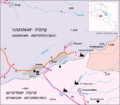Aghjots Vank
| Aghjots Vank Աղջոց վանք | |
|---|---|
Ivane Mkhargrdzeli and Prince Grigor Khaghbakian. | |
| Groundbreaking | Unknown |
| Completed | Saint Stephen Church, early 13th century Saints Paul and Peter Church, 1270 Gavit, late 13th century |
Aghjots Vank (
Etymology
The etymology of Aghjots Vank is derived from the nearby abandoned village of Aghjots.
History and Site
According to local folklore, the monastery was founded by
The exact date that the monastery was founded is unknown. What is known is that the majority of the monastery was commissionned by Prince Grigor Khaghbakian and his wife Princess Zaz in 1217.[1]
The complex of Aghjots Vank consists of the church of Surp Stepanos or Saint Stephen, the church of Saints Paul and Peter, and the adjacent gavit.
Surp Stepanos church was built during the early 13th century and is the main church within the complex. It has a cruciform plan, four portals and a vaulted church of S. Poghos Petros attached to the northern wall.
The church of Paul and Peter was built in 1270 and has remarkable
A gavit that has since partially fallen down the hill, was added to the western end of S. Stepanos in the second half of the 13th century. Further construction was funded by
Aghjots Vank was sacked by the Persians in 1603 and restored soon after. It was destroyed again in the Earthquake of 1679 that destroyed the nearby monastery of Havuts Tar and the pagan temple of Garni. The monastery was despoiled again in the 18th century and permanently ruined during the Armenian–Tatar massacres of 1905–1907. It now sits in ruins within the Khosrov State Reserve.
Numerous inscriptions may be seen on the churches and gavit. The site has several
Aghjots Monastery is included in the watch list of World Monument Fund.[3]
Gallery
-
Khatchkarcross in Aghjots Vank
-
Human figure in Aghjots Vank
-
Human figure in Aghjots Vank
References
Footnotes
- ISBN 978-0-88402-183-4.
- ^ ISBN 978-0-88402-183-4.
- ^ "Aghjots Monastery". World Monuments Fund. Retrieved 2019-12-11.
Bibliography
- Kiesling, Brady (June 2000). Rediscovering Armenia: An Archaeological/Touristic Gazetteer and Map Set for the Historical Monuments of Armenia (PDF). Archived (PDF) from the original on 6 November 2021.
- Kiesling, Brady (2005), Rediscovering Armenia: Guide, Yerevan, Armenia: Matit Graphic Design Studio








